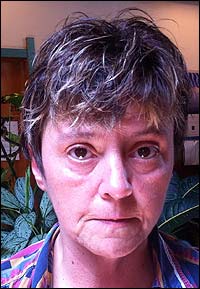
A New Mental Hospital?
Investing in bricks and mortar will not stop abuse
By Lynne Salvi
EDITOR’S NOTE: This column was submitted to EW just before Lynne Salvi of Eugene died after driving her car into the Willamette River in Portland Sept. 23. A memorial service was held Sept. 28. A longer version can be found on the MindFreedom website at http://wkly.ws/13w
 |
The National Alliance for Mental Illness (NAMI) held an open meeting at the Lane County Mental Health building in Eugene Aug. 30, giving the public an opportunity to hear about the issues regarding a proposal to build a new state psychiatric facility in Junction City.
Speakers for the meeting were Charlie Wright, chair of the Lane County Mental Health Advisory Subcommittee; Bruce Abel, program manager of LaneCare mental health agency: Rep. Val Hoyle; Linda Hammond, coordinator for the state hospital project in Junction City; Chris Bouneff, executive director of NAMI Oregon; and Angella Kimball, director for NAMI state policy.
Hammond and Hoyle were the only two on this panel holding positions allowing them the authority to vote on the behalf of Oregonians regarding the fate of those committed in Oregon state psychiatric hospitals.
Kimball presented a brief and overarching account of problems patients face in Oregon’s state psychiatric facilities. A major focus was Oregon State Hospital (OSH) in Salem, famously known as the institution where One Flew Over the Cuckoo’s Nest was filmed. There is also a branch of OSH located in Portland.
Kimball said the conditions at OSH in Salem caught major attention in 2002 when a patient was verbally abused without hospital staff realizing his family’s social ties. Allegations of mistreatment in OSH alerted state and federal authorities leading to many investigations since 2003. These investigations have uncovered a shocking trail of horrendous abuse and outrageous living conditions.
In August 2004, Gov. Ted Kulongoski’s inspection stated the standard of care at OSH “is atrocious.” In September 2004, other official investigations revealed, “Oregon allowed two of its employees to molest a mentally ill girl in their care and then paid her to keep quiet.” In 2005, OSH made headlines after rows of “cremains” were discovered in the hospital’s basement.
Negotiations with authorities continue to stall as representatives say the lack of state funds for community based programs cause overcrowding in OSH. A large percentage of committed patients are needlessly being held without justification when these patients would be better served in discharged placement programs.
Then in October 2009, Moises Perez died and laid in his bed across from the nurses’ station for hours before he was noticed. In light of his death, the U.S. Department of Justice sent another letter citing OSH’s obligations under the Americans with Disabilities Act as conditions continued to be a great concern. “Our defunded economic times” is the running scapegoat for not taking actions sooner.
Under this mounting pressure, representatives now claim that Oregon can afford a new $280 million-plus state psychiatric facility as a way to fix the problems: a 620-bed psychiatric unit in Junction City and another 300-bed unit down the road. Their first target to finance this is the already deflated funds for mental health community based programs including programs for discharge placement.
Charlie Wright told a story of a young man currently committed at OSH. This man was walking down a sidewalk, stopped and yelled towards a group in the distance who were golfing. Unfortunately, one of the men golfing held a high professional title, and it was later found that this young man was not taking the psychiatric medications that were being prescribed to him. After several years committed in OSH, this man has 10 more years to go for merely raising his voice and yelling towards a crowd.
Val Hoyle was asked about alternative treatments in mental health care and two highly regarded documentaries recently shown in Eugene. These films are centered on successful alternative treatments implemented for mental health clients outside the U.S. These alternative treatments are far more humane, costing fractions compared to a new hospital.
Despite all of the reporting about OSH history of abuse and overcrowding, there is more interest in the creation of new jobs for Junction City and its neighboring areas, rather than providing better services for those who receive mental health care. State lawmakers say Oregon can afford to spend millions during difficult economic times to build another hospital and claim this is the way to solve horrendous issues of abuse and overcrowding.
Is the difference between those who supposedly need these beds and those who push to build them the fact that one has a label and the other holds a title?
It seems quite clear that questionable actions in public can be disregarded by technical difficulties with video for some and others will be strapped to beds. A young man will lose 12 years of freedom, and I struggle to see the crime he committed. I overheard one of the panelists assert, “We need a place to put all of these people … some are waiting on the Johnson Unit more than a month for a bed in the state hospital.”
Is there an agenda to create criminals out of those who have psychiatric diagnoses in order to create jobs at their expense?